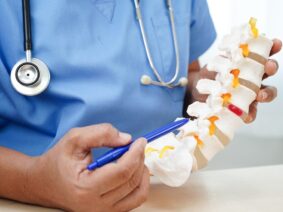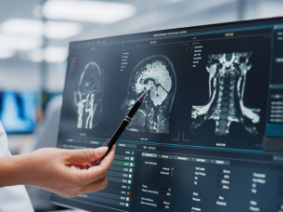Kyphoplasty is a minimally invasive spine surgery done for the purpose of reducing or eliminating pain and disability due to vertebral compression fractures (VCFs). It is also designed to prevent further collapse of the fracture, which results in worsening of postural problems and spinal deformity. This surgery may improve posture by restoring normal spinal alignment and height.
VCFs are a major healthcare problem and are most commonly caused by osteoporosis (weakening of the bones). In fact, VCFs as a result of osteoporosis occur in approximately 700,000 Americans every year.
Fracture risk increases with age, with four in 10 white women older than age 50 experiencing a hip, spine or vertebral fracture in their lifetime. VCFs can lead to severe and/or chronic pain, impaired activities of daily life, disfigurement and increased risk of various other impairments, including psychological distress.
The usual location of compression fractures is in the thoracic spine (located in the upper and middle back). However, they can also occur in the lumbar spine (lower back).
While some VCFs can be treated with medications, bed rest and rehabilitation, surgery is indicated in those whose fractures entail spinal instability as well as abnormal function (neurological impairment).
What It Treats
Kyphoplasty treats fractures of the vertebral body due to:
- Osteoporosis, the major cause of vertebral compression factors
- Cancer, such as bone metastasis and multiple myeloma
- Benign lesions that are noncancerous and/or caused by infection or osteoporosis
How It Works
To verify a VCF, a patient is examined by a doctor, who will test the suspected vertebrae for sensitivity and tenderness. A clinical evaluation may include complete blood cell count test and diagnostic imaging (X-rays, magnetic resonance imaging [MRI] and/or radioisotope bone scan) to pinpoint the fracture(s).
The kyphoplasty procedure itself is performed in a hospital or outpatient facility, depending on the overall health status of the patient and nature of the procedure, and begins with either local or general anesthesia. As the patient lies face down on the table, a small incision is made in the back, through which a narrow tube is inserted. Real-time X-ray images guide the surgeon to the proper area to be treated. A balloon is inserted through the tube and into the vertebrae, where the balloon is carefully inflated. The balloon thus inflates the fracture, returning the vertebrae to a more normal position. The balloon also creates a cavity. Using special instruments, the doctor fills that cavity with a substance that works like cement. The procedure takes about an hour for each vertebra involved.
A Medtronic-sponsored trial, which compared kyphoplasty to nonsurgical treatment, found the following benefits for patients with spinal fractures who underwent the surgery:
- They experienced three times greater pain reduction one week following the procedure than those treated with nonsurgical methods.
- They experienced four times better quality of life than those treated with nonsurgical methods.
- They had five more days of unrestricted activity per month than those treated with nonsurgical methods.
A controlled trial published in The Lancet outlines findings that suggest balloon kyphoplasty is also an effective and safe procedure for patients with acute vertebral fractures.
Recovery
Following about an hour of recovery time after the procedure, patients may either be allowed to return home on the same day or directed to stay overnight in a hospital. Patients may also be allowed to walk shortly after their surgical recovery.
Patients may experience some soreness for several days at the site where the needle entered the spine, but may also notice relief from the pain they were experiencing prior to surgery.
The doctor will provide specific instructions on resumption of normal daily activities following the surgery.
Kyphoplasty is one of the specialties at Neurosurgical Associates of Central Jersey. For more information, or to schedule an appointment with a specialist to explore this procedure, contact us today.



